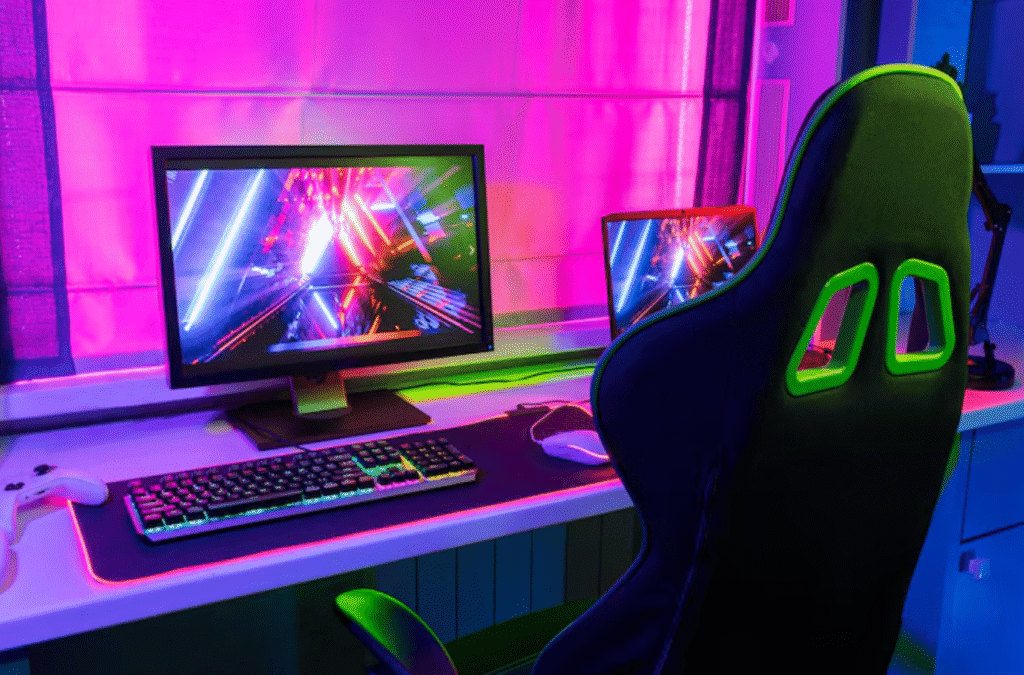The journey of PC game graphics is one of the most dramatic evolutions in technology and entertainment. What began with simple 2D pixels has transformed into near-photorealistic 3D worlds, powered by cutting-edge GPUs, real-time ray tracing, and advanced game engines. In 2025, we’re witnessing a level of visual fidelity once thought impossible—where digital characters look human and virtual landscapes mirror reality.
Let’s explore how PC game graphics have evolved over the decades, the technologies that made it possible, and where we’re heading next.
1. The Pixel Era: 1980s – Early 90s
Key Traits:
- 2D sprite-based graphics
- Limited color palettes (e.g., 16 or 256 colors)
- Simple animations and environments
Iconic Games:
- Prince of Persia (1989)
- Commander Keen (1990)
- Doom (1993) – a leap forward in first-person visuals
Technological Highlights:
- VGA graphics (640×480 resolution)
- Raster graphics
- First-person perspective introduced in basic form
Impact: These foundational years established visual language in gaming. Though primitive, the bold use of color, creativity, and imagination made these games legendary.
2. The 3D Revolution: Mid-1990s – 2000s
Key Traits:
- Polygonal 3D models
- Low-res textures
- Basic lighting and shadows
Iconic Games:
- Quake (1996)
- Half-Life (1998)
- Deus Ex (2000)
Technological Highlights:
- Rise of dedicated 3D graphics cards (NVIDIA RIVA TNT, Voodoo)
- DirectX and OpenGL APIs
- Hardware-accelerated 3D rendering
Impact: PC games entered the third dimension, unlocking new genres like immersive sims and 3D shooters. Despite jagged edges and clunky animations, players were blown away by the realism of the time.

3. Realism Emerges: 2000s – Early 2010s
Key Traits:
- Improved texture quality
- Dynamic lighting and particle effects
- Facial animations and motion capture
Iconic Games:
- Crysis (2007) – the gold standard of PC graphics
- The Elder Scrolls IV: Oblivion (2006)
- The Witcher 2 (2011)
Technological Highlights:
- Multi-core CPUs and GPUs
- PhysX, Havok for physics simulations
- Shader Model 3.0+
Impact: This was the age of “Can it run Crysis?” as gamers chased high-end rigs to experience games at max settings. Graphics became more immersive, pushing hardware to its limits.
4. The Modern Era: 2013 – 2020
Key Traits:
- High-definition textures and models
- Complex shaders and reflections
- Advanced animation and facial scanning
Iconic Games:
- The Witcher 3 (2015)
- Red Dead Redemption 2 (2019, PC in 2020)
- Cyberpunk 2077 (2020, post-patch)
Technological Highlights:
- DirectX 12, Vulkan APIs
- High-end GPUs like RTX 2080/3080
- 4K resolution gaming
Impact: This period solidified PC’s dominance in graphical fidelity. Large studios used photogrammetry and scanned textures to achieve near-realistic environments. Modding communities also enhanced visuals well beyond original developer intentions.
5. The Ray Tracing & AI Era: 2020 – 2025
Key Traits:
- Real-time ray tracing for accurate lighting, shadows, and reflections
- AI-driven upscaling (DLSS, FSR, XeSS)
- Immersive particle effects, realistic skin shaders
Iconic Games:
- Microsoft Flight Simulator (2020+)
- Baldur’s Gate 3 (2023)
- Alan Wake 2 (2023)
- Stalker 2 (2024)
Technological Highlights:
- RTX 4000 and 5000 series GPUs
- Unreal Engine 5 (Nanite, Lumen)
- AMD FSR 3.0 and NVIDIA DLSS 3 with Frame Generation
Impact: Games started achieving cinematic quality in real time. Developers now use AI to enhance resolution and frame rates, allowing even mid-tier systems to handle ultra visuals. Lighting and shadows behave as they would in the real world—no faking required.
6. Tools Behind the Magic
- Game Engines: Unreal Engine 5, Unity, CryEngine
- 3D Modeling Software: Blender, Maya, ZBrush
- Textures and Materials: Substance Painter, Quixel Megascans
- AI-Assisted Development: NVIDIA ACE, procedural world generation
These tools empower even small studios to create AAA-level visuals—leveling the playing field between indie and big-budget developers.
7. Challenges in Graphics Evolution
Despite the beauty of modern visuals, there are trade-offs:
- Hardware demands: Newer games require powerful, often expensive rigs.
- Optimization issues: Some games are graphically stunning but poorly optimized (Cyberpunk 2077, The Last of Us Part I PC launch).
- Development time and cost: High-fidelity graphics demand large teams, longer cycles, and increased risk.
8. What’s Next for Graphics? (2025–2030)
Hyperrealism
- Photorealistic faces and animations with emotion-mapping
- Real-time global illumination and physically accurate materials
Procedural Graphics
- AI-generated textures and landscapes reduce workload
- Infinite game worlds that adapt on the fly
Volumetric Rendering
- Simulations of clouds, smoke, and fog at cinematic levels
Neural Rendering
- Blending real photography with digital environments (used in early experiments by NVIDIA and Intel)
XR and Holography
- Immersive 3D environments in AR/VR or holographic displays
From the early days of pixel sprites to today’s lifelike digital vistas, PC game graphics have come an astonishingly long way. But it’s not just about looks—better graphics deepen immersion, emotion, and storytelling.
As GPUs grow smarter, engines more powerful, and AI more integrated, the line between virtual and reality continues to blur. We’re no longer asking “Can it run Crysis?”—we’re wondering how long until we can’t tell a game from a movie.
In 2025, we’re standing on the edge of a visual revolution. And it’s only just beginning.



